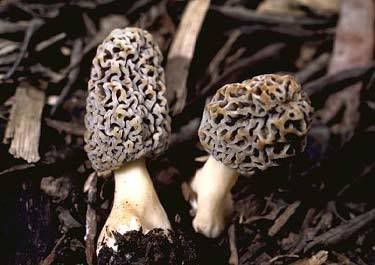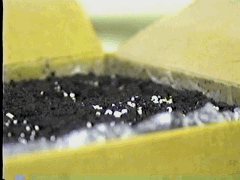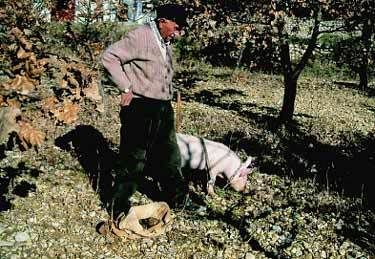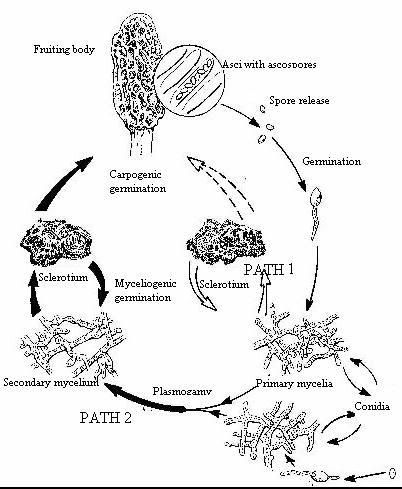
[MMM. I will always remember my first morel.]
(mushrooms, other fungi; some delicious and nutritious, some deadly poison)
Mycelium is an excellent base for starting the commodity ecology, because literally it was the basis for all land base life: the first land dwellers that prepared everything chemically for soil formation that other creatures utilized later. See this short stunning video, below, about the history and importance of mycelium introductions as the base of everything.
Paul Stamets: 6 ways mushrooms can save the world (17 minutes)
http://www.ted.com/talks/view/id/258
"Entrepreneurial mycologist Paul Stamets seeks to rescue the study of mushrooms from forest gourmets and psychedelic warlords. The focus of Stamets' research is the Northwest's native fungal genome, mycelium, but along the way he has filed 22 patents for mushroom-related technologies, including pesticidal fungi that trick insects into eating them, and mushrooms that can break down the neurotoxins used in nerve gas. There are cosmic implications as well. Stamets believes we could terraform other worlds in our galaxy by sowing a mix of fungal spores and other seeds to create an ecological footprint on a new planet."
Re-basing commodity ecology, the ecologizing of human commodification, on mycelium seems the sounded basis to start. Moreover, it is probably to be expected because mycelium was the first arriving "'life organ' of ecology" that these species would be an integral start for life--and for other commodity ecology paths. It has THE MOST cross-connects or overlaps SO FAR with leads into other categories. It connects very well with:
58. Remediation
16. Herbicides/Pesticides
6. Soils/Dirt/Hydroponics
5. Garbage/Garbage disposal
7. Drugs/Medicines
11. Mycelium based food
72. Packing Materials (for seeding forests, mycelium and seeds embedded)
THAT means mycelium's many local multiple consumptive positional uses makes it a good place to start upon the commodity ecology for branching in multiple directions from this locus. He says 6 ideas. I count seven. Really, all the difficulties with sustainability are already solved. It merely means putting all the pieces together combined with challenging the corrupt developmentalism with the bioregional state institutional arrangements, challenging the arrangements that keep sustainability, sustainable politics, and territorial states from happening.
Fungi as Food Sources
Traditionally, mushrooms were identified and picked for food. The mushrooms you see at the markets are now commercially cultivated. These mushrooms are grown in highly controlled environments at specific temperature and humidity levels.
Mushrooms that made their way to our dinning tables
Shiitake Mushroom (Lentinus edodes)
Also known as Japanese mushroom, Chinese mushroom and mushroom of the forest.
It is a saprophytic fungus which colonises dead wood of various species. In Japan, it occurs naturally in a type of tree called Shii. Therefore the name Shiitake in Japanese.
It is of medium size, with a cap diameter of approximately 2-4" and a stalk that is 4-5" long. The cap is round, brown and "scaly" while the stipe is yellowish-white with a prominent, persistent annulus.
Economic Importance of Shiitake Mushrooms
Shiitake Mushroom is the second most cultivated mushroom in the world, only after Agaricus, the Paris mushroom. Besides China and Japan, Shiitake is also widely cultivated in Taiwan, Thailand, Korea, Singapore as well as Holland, the United States and Canada.
Shiitake's protein has a full complement of essential amino acids so it can be used extensively in a vegetarian diet. Its active ingredient, Lentinan (a polysaccharide), has been shown to reduce cancer and cholesterol.
The Shiitake Mushroom is as common in Asian countries as Agaricus bisporus is in the West. Its cultivation method is similar to that of P. ostreatus.
Agaricus Mushrooms
This genus includes the commercially cultivated Agaricus brunnescens (bisporus). This is not a tropical species and those sold in supermarkets are imported [from Europe/North America.]
The basidiocarp consists of a stipe bearing a ring and pileus. the pileus is cup-shaped and when fully opened, the gills rapidly turn dark brown.
The young button stage is marketed as 'Button Mushrooms'.
Oyster Mushroom (Pleurotus ostreatus)
This species is a saprobic fungus that can commonly be found, growing on dead trees, in nature. This large white, gray-brown or ivory-colored mushroom is named for its oyster shell-like shape. Its cap can grow to around 5-15 cm in its longest dimension. It has white gills running down a very short, off-center short and white stalk.
Paddy Straw Mushroom (Volvariella volvacea)
The Paddy Straw mushroom is large. Its cap, if allowed to mature, often exceeding 5" in diameter, and is light to dark gray.
When young, the mushroom is entirely enclosed in a white, egg-like structure called the volva. As the mushroom develops, the stalk will elongate and push the cap upward, thereby rupturing the volva, leaving only a cup-like structure at the base of the stalk.
Many Chinese recipes require this mushroom. It is commercially cultivated on a mixture of raw cotton waste and rice bran and harvested in the button or egg stage before the pileus emerges. In the wild, the fungus tends to grow on decaying vegetation and wood.
Wood Ear (Auricularia polytricha)
The earliest record of this species dated back to about 200-300 BC. It is now cultivated throughout the South Pacific and Asia. It has a common name that refers to the ear-shaped structure of the fruiting body: Mu-Er (wood ear) in China, and Pepiao (ear) in Hawaii.
The fruiting bodies are usually brownish to reddish brown and has a consistency of jelly. In nature, the two species are saprobes that grow on tree logs.
The cultivation of these species is the same as that of the Shiitake Mushroom. It is cultivated on logs and also on a mixture of saw dust and cotton waste.
Silver Ear (Tremella fuciformis)
Commonly known as 'Jelly Fungi' because of the gelatinous, jelly-like nature of the basidiocarps which are wrinkled or consist of leaf-like folds.
It is a saprophyte growing on decaying branches. This species produces a white, lobed, irregularly shaped fruiting body.
It is has been long utilized as a "herb" to cure many ailments. Tremella fuciformis is also known as 'silver ear' or 'snow ear' fungus, is widely eaten in the east. Chinese believe that it could cure tuberculosis, high blood pressure and common cold. It is also a Chinese delicacy.
The method of cultivation of this species is identical to that of the Shiitake and Auricularia since it is a wood inhabiting species.
Enoki (Flammulina velutipes)
The Enoki is a very small, delicate mushroom. The species is whitish-yellow, with a cap not more than ¼- ½ " in diameter. The stalk is approximately 3-4" long and about ¼" thick.
It is cultivated on sawdust medium in a large container. It would seem to be an unlikely candidate for cultivation because of its small size, but seems to be commonly sold in supermarkets. The origin of cultivation of this species is believed to be in Japan.
These mushrooms are believed to contain medicinal properties...
Lingzhi or Reishi (Ganoderma lucidum)
Ganoderma is not a palatable mushroom. It can be used to make tea or soup.
It is a large, hard and leathery fungus with sessile or stalked basidiocarps. the undersurface of the basidiocarp is characterised by the presence of many tiny pores.
It is one of the most respected ingredients in traditional oriental medicine. It is cultivated for its medicinal and tonic values.
Cordyceps (Cordyceps sinensis)
This fungus is a parasite growing on insects. It produces a long club-shaped structure or stroma on the dead body of the host.
Cordyceps sinensis that grew on caterpillars.
When the caterpillars died, the fungus is dried and used in traditional Chinese medicine as a tonic and for various ailments.

Isn't it a joy to see these mushrooming in front of your eyes?
Cultivation of common edible mushrooms
We will discuss some of the better known species from both Western and Eastern cultures.
In these species, three methods of cultivation are used:
1. Composted substrates: usually horse manure and straw or just straw alone
2. Woody substrates: logs or sterilized sawdust
3. Inoculation onto the roots of living trees: this is done only for those mushroom species that form mycorrhizae with the roots of certain species of trees.
[4.] Compared to far more complicated 26-step artificial morel growth processes.
Agaricus bisporus is the most cultivated mushroom in the world.
The substrate on which it is cultivated includes horse manure, wheat straw, corncobs and several plant or animal wastes.
The composting process is a mixed fermentation involving a range of microorganisms, bacteria and other fungi, which will degrade some of the complex compounds such as lignin and cellulose. The biological activities of the microorganisms make the compost warm. When the compost cools, it will have a consistency similar to that of thick oatmeal and will provide an environment well suited for mycelial growth of A. bisporus. The mycelium that is inoculated into the compost is referred to as the spawn.
Following growth of mycelium throughout the substrate, a casing layer, is placed over the substrate. The casing layer is critical in the fruiting body formation of A. bisporus. The biological activity of bacteria, various soluble salts, together with the lowering of the temperature between 14-18o C, will optimize fruiting body production in A. bisporus.
Oyster Mushroom (Pleurotus ostreatus)
It was first cultivated on tree logs. In late 1950's, an important innovation developed in which sawdust was used as the substrate material. This method would become important, not only in cultivation of Pleurotus, but all cultivated mushrooms cultivated on wood.
This process involves placing sawdust in a polypropylene bag that is then sterilized, cooled and inoculated with Pleurotus. [The more complicated morel process involves this at one stage.] The inoculated substrate is now placed in the dark, and after the mycelium has grown throughout the substrate, openings are cut through the bag where fruiting bodies will develop. This process is more ecologically sound because it utilizes waste material as the substrate for cultivation of the mushroom. It also shortens the period of fruitbody formation to approximately two months.
Although P. ostreatus appears to be a popular cultivated mushroom, it is soft, fragile and has the shortest shelf life of any cultivated mushroom. It often has bacterial or fungal contamination within a day or two of arriving at the market place.
Paddy Straw Mushroom (Volvariella volvacea)
Paddy straw is practically the only material used to prepare the substrate for cultivation of the Paddy Straw Mushroom even though other substrates (eg. rice straw, cotton waste, dried banana leaves and oil palm bunch waste) had been successfully used but with lower yield. The cultivation method of this mushroom is similar to that of Agaricus bisporus. In Indonesia and Malaysia, mushroom growers just leave thoroughly moistened paddy straw under trees and wait for harvest.

[Pig trained to look for (and eat unless you watch it) truffles]
Truffles (Tuber melanosporum and other related species)
Unlike the other fungi that have been discussed, truffles are actually members of the division Ascomycota rather than Basidiomycota. They grow underground and form mycorrhizae with certain species of European Oaks.
Fungi that form mycorrhizae have never been cultivated, at least not with the two methods previously described, because of their obligate relationship with the roots of trees. Thus, a different strategy was required to "grow" truffles. The environmental and nutritional requirements for formation of fruitbodies of truffles are not known.
In cultivation of truffles, it is important to have a background in ecology as well as mycology in order to grow truffles successfully. T. melanosporum will only grow where its host tree can grow. Within its host range, one method of "cultivating" truffles requires a lot of land where the host trees can be planted. To ensure truffle formation, the mycelium of the truffle is inoculated into the roots of these trees.
Because truffles grow underground, they must be dug out. The best way to find truffles is to let pigs, and sometimes dogs, "sniff" them out.
Mushrooms Cultivated in Singapore
Shiitake Mushroom (Lentinus edodes)
The Shiitake mushroom has the distinctive advantage of a much longer shelf-like because they are more commonly sold dried while most other mushrooms are sold fresh. A great deal of research has been carried out, in Japan, on the nutritional and medicinal value of the Shiitake. It is said to be rich in vitamin D2, has anti-tumor and antiviral properties and removes serum cholesterol from your system.
Growing morels on your own? Check this out this web site.
(Source: http://www.gaia.org/farm/mushroom/morel.html)
In the local scene...
To bridge the gap between academic R&D activities and business, a few of our Singaporean entrepreneurs took the opportunity to enter business ventures to cultivate mushrooms using agricultural waste.
The cultivation of mushrooms is a blooming business now. At least 15 tonnes of mushrooms are cultivated locally monthly for export and for local markets. Most of the locally-cultivated mushrooms are the Shiitake mushrooms. Those fresh mushrooms you see at your supermarkets could have been harvested from their farms.
Not only have these enterprising entrepreneurs found a way to shorten the production time of certain mushrooms, they can now produce these mushrooms are year round using the latest biotechnological methods!
Truffles
What is a truffle ?
Truffle, a fungus belonging to the order Tuberales, is a subterranean European fungi. The fruiting body, which is often referred to as the truffle, is usually round and pitted, and 1-7 cm (0.5-3 inches) in diameter.
Truffles have been collected for at least 3600 years. They have a tantalizing taste and aroma. The flesh of all truffles is nearly white when young; as the truffle matures, the flesh becomes darker with a marbling of lighter tissue.
Economic Importance of Truffles
Truffles are undoubtedly the most sought-after delicacy among the fungi with great economic value. The taste and aroma of commercially collected truffles is so intense that they are used as a flavoring instead of a separate dish.
How does truffle grows?
Growing underground, they are difficult to find and very expensive as a result. It is perhaps the most highly prized of all edible fungi.
Truffle-producing fungi have also formed symbioses with trees (mycorrhizae) because fungi cannot make their own food. The hyphae coat the roots of the tree and help their host absorb soil minerals. In return, the tree host provides the fungus with carbohydrates and other nutrients, the product of the tree’s photosynthesis. Truffles contain spores for reproduction. Many truffles have a strong smell and attract animals such as chipmunks, rabbits and squirrels to help disperse their spores by digging them up.
How are truffles recovered from the soil?
In North America, truffle collectors use clues to find truffles.
First, it must be warm and the soil moist. Truffles are often found 10 to 14 days after a heavy rain. The umbrella-shaped mushrooms which pop up after a good rain can be used as a kind of clock. Look for truffles after these mushrooms have started to collapse.
Second, the right trees present must be present. Truffles are formed by fungi that are partners (ectomycorrhizal) with certain trees such as pines, firs, oaks, hazel nuts, hickories, birches, beeches, and eucalyptus.
Due to truffles' distinctive odour, their underground location may be determined by animals trained for this purpose. Every Spring, truffle hunters in Europe take to the woods, hoping that the sensitive noses of their trained pigs and dogs will lead them to buried treasure.Several species are highly esteemed delicacies, particularly the Perigord truffle, Tuber melanosporum, and are usually found under oak or beech trees.
Pigs and dogs are the usual truffle hunters.
Attempts are being made to farm truffles due to the difficulty in finding them in the wild. The harvest has steadily decreased for the last 90 years, due to forest destruction and the killing of trees by air pollution. France produced 1,000 metric tonnes of truffles in 1892; now, only 50-90 tonnes are harvested each year.
More visuals of truffles and 'truffleculture' in the Languedoc (southern France), via the village website of Uzès featuring their annual truffle festival.
More on Morels
Morels are found on the ground in a variety of habitats, including moist woodlands and in river bottoms. They are delicious and thus are cultivated for economic reasons.
The surface of a morel is covered with definite pits and ridges. It is about 2" to 12" tall. There are three common species of morels:
* The common morel (Morchella esculenta): When young, this species has white ridges and dark brown pits and is known as the "white morel." As it ages, both the ridges and the pits turn yellowish brown, and it becomes a "yellow morel".
* The black morel (Morchella elata): The ridges are gray or tan when young, but darken with age until nearly black. The pits are brown and elongated. These morels are best when picked young; discard any that are shrunken or have completely black heads.
* The half-free morel (Morchella semilibera): This is the exception to the rule that morels have the bottom of the cap attached directly to the stem. The cap of the half-free morel is attached at about the middle. These morels have small caps and long bulbous stems.
Although morels are quite distinctive, it is still possible to confuse them with false morels. Some of these false morels are actually poisonous!

Morel Life Cycle
A technique of artificially growing morels (with their complicated life cycle) was developed by mycologist Gary Mills after much trial and error, and observations of morels growing in nature. What is linked here is a sequence which Gary demonstrated for the PBS series, Scientific American Frontiers. The temperature, humidity, substrate and other detailed parameters were placed in the public domain by George Robert Trager.
2 comments:
Mushroom growing can make (profitable and nutritious) use of agricultural and forest wastes that have little other human use. Some, like morels or truffles, can be so profitable it may make forest preservation lucrative in certain areas.
Amiable fill someone in on and this enter helped me alot in my college assignement. Thanks you for your information.
Post a Comment